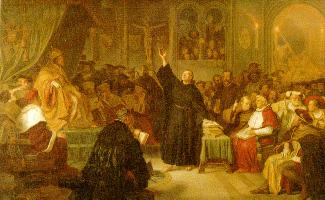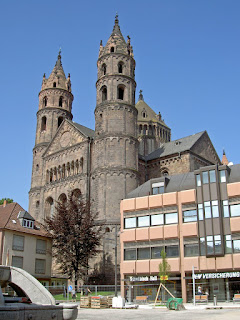 On the trail of Martin Luther - we have followed this man from Eisenach and Wartburg in the former East Germany to the resting place of some of his work in the Gutenberg Museum and now here in Worms, where a Diet was held that for all intents, began the official Reformation. Almost a century before Luther, Jan Huss, another reformer of a more pious lean, had suffered death by fire as a heretic. He prophesied: "You roast a lean goose [Huss] today, but from my ashes a swan will ascend, in a hundred years, that you cannot roast." Luther apparently regarded himself as the swan who had come to reform the church.
On the trail of Martin Luther - we have followed this man from Eisenach and Wartburg in the former East Germany to the resting place of some of his work in the Gutenberg Museum and now here in Worms, where a Diet was held that for all intents, began the official Reformation. Almost a century before Luther, Jan Huss, another reformer of a more pious lean, had suffered death by fire as a heretic. He prophesied: "You roast a lean goose [Huss] today, but from my ashes a swan will ascend, in a hundred years, that you cannot roast." Luther apparently regarded himself as the swan who had come to reform the church. The Diet was called by the ruling authorities with the idea of furthering their political agenda. The Catholic Church wanted to put a halt to Luther's dissenting views. Unfortunately for the church, the journey to the Imperial Diet did not embody the repentance the church had hoped for, nor the hoped for political ends the aristocracy was seeking. The journey to Worms was more like a victory march; Luther was welcomed enthusiastically in all of the towns he went through. He preached in Erfurt, Gotha and Eisenach. (Erfurt is for another trip) He arrived in Worms on April 16, 1521 and was also cheered and welcomed by the people there. His passionate and outspoken manner garnered both anger and appeal.

Luther's appearance at the Imperial Diet was described as objective, clever and well thought out. He had to appear before the Emperor twice; each time he was clearly told to take back his teachings. Luther didn't see any proof against his theses or views which would move him to recant: "Unless I am convinced by Scripture and plain reason - I do not accept the authority of the popes and councils, for they have contradicted each other - my conscience is captive to the Word of God. I cannot and I will not recant anything for to go against conscience is neither right nor safe. God help me. Amen. "The infamous saying, "Here I stand. I cannot do otherwise." does not come from Luther.
After he left the negotiation room, he said, "I am finished." He was for finished for a time. Luther was dismissed, and not arrested because he had a letter of safe conduct (Schutzbrief) which guaranteed him 21 days of safe travel through the land. He headed home on April 25. When Luther and the princes who supported him left Worms, the emperor imposed an Imperial Act (Wormser Edikt). Luther is declared an outlaw (he may be killed by anyone without threat of punishment). On the trip home, Elector Friedrich the Wise allowed Luther to be kidnapped on May 4; Luther knew about it beforehand. This took place on the one hand to guarantee Luther's safety and on the other hand, to let him disappear from the scene for a short while. There were even rumors of Luther's death. This action also helped the Elector not to endanger himself because he could have been held liable for protecting an outlaw and heretic. Luther was taken to the secluded Wartburg and the Reformation had time to stabilize and strengthen itself. We visited this site as referenced in an earlier blog and acquired a sense of the austere and isolated conditions Luther was forced to endure. Having spent many years as a monk probably prepared him for this cloistered existence. In Worms we followed the trail of his stay with a guided tour in English. The town had doubled in size from about 5000 at the time in anticipation of the Diet. Available lodging was at a premium; a bed was made available for Luther and now only a plaque on the wall of a modern building tells the story of his stay in this location.
In Worms we followed the trail of his stay with a guided tour in English. The town had doubled in size from about 5000 at the time in anticipation of the Diet. Available lodging was at a premium; a bed was made available for Luther and now only a plaque on the wall of a modern building tells the story of his stay in this location.Worms is a city of considerable antiquity going back to Celtic times, then Roman and under continous habitation of thousands of years. The city was completely destroyed more than once, the last time during the Allied bombing of 1945. Attempts to target chemical plants on the outskirts of town were missed and much of the city core was destroyed. Nevertheless, there were some important centuries old buildings left largely intact. This beautiful Romanesque cathedral was spared. It dates from the 12th century and contains beautiful stain glass and guilded altars.
This city is steeped in history but not a lot remains to bear witness of it. Museums serve to recount the tales of bygone eras. Worms attempts to capture the past through art, literature and playing upon the imagination of its visitors. Some vestiges still remain. For example, the oldest Jewish cemetery in Europe is located here. In addition, the churches represent a cross section of architectural styles from Romanesque to modern. The first impression leaves little to indicate it's rich prior history. I had to dig a little deeper to find the gems, but they are here!
No comments:
Post a Comment